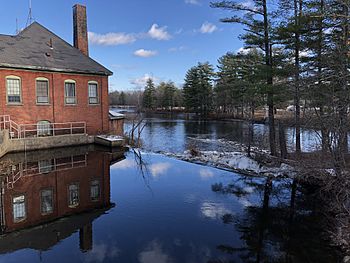Piscassic River facts for kids
Quick facts for kids Piscassic River |
|
|---|---|

The Piscassic in Newmarket, NH
|
|
| Country | United States |
| State | New Hampshire |
| County | Rockingham |
| Towns | Fremont, Epping, Newfields, Newmarket |
| Physical characteristics | |
| Main source | Fremont 148 ft (45 m) 43°0′30″N 71°6′2″W / 43.00833°N 71.10056°W |
| River mouth | Lamprey River Newmarket 30 ft (9.1 m) 43°5′25″N 70°56′28″W / 43.09028°N 70.94111°W |
| Length | 15.3 mi (24.6 km) |
| Basin features | |
| Tributaries |
|
The Piscassic River is a small river in southeastern New Hampshire, United States. It is about 15.3 miles (24.6 km) long. This river flows into the Lamprey River. The Lamprey River then connects to Great Bay and the Piscataqua River. All these waters eventually reach the Atlantic Ocean.
The Piscassic River starts in the northeast part of Fremont. It flows east through flat, swampy areas in the town of Epping. When it reaches Newfields, another river called the Fresh River joins it. After that, the Piscassic River turns northeast. It winds through hilly areas until it reaches Newmarket. There, it meets the Lamprey River. The Fresh River joins the Piscassic near a marshy area with beaver ponds. This spot is just upstream from the Piscassic Ice Pond.
River History and Uses
The lower part of the Piscassic River was once used like a canal. It helped boats travel between Neal's Mills in Newfields and the mouth of the Piscassic. This is where the Piscassic River meets the Lamprey River.
Neal's Mills and Barges
There was a small pond at the bottom of some rapids. This pond was used to unload and turn barges. You can find this spot downstream from the ruins of Neal's Mills. It is located between the Piscassic Road bridge and the B&M railroad bridge in Newfields. A path for mules runs along the northwest bank of the river. Mules would have pulled the barges along this path.
The Piscassic Ice Pond
A small dam just upstream from the Piscassic Road Bridge creates the Piscassic Ice Pond. Long ago, a wooden building called an icehouse stood next to this pond. It was just east of the dam. This icehouse had a conveyor system made of wood and iron. This system moved ice from the pond up to a door about 15 feet (4.6 meters) high.
In the early 1900s, the ice on the pond often grew very thick, sometimes 18 inches (46 cm). Workers would use large saws to cut the ice into big pieces, about 3 to 4 feet (0.9 to 1.2 meters) wide. Teams of horses, wearing special ice shoes, would help pull the ice out of the pond. Then, they would haul it to the conveyor. The icehouse had inner walls that were about 2 to 3 feet (0.6 to 0.9 meters) thick. These walls were filled with sawdust to keep the ice cold. The icehouse eventually rotted and fell down in the 1950s. Today, there is very little left of it.



